Crossroads Community Association Celebrates 20 Years Creating a Neighborhood
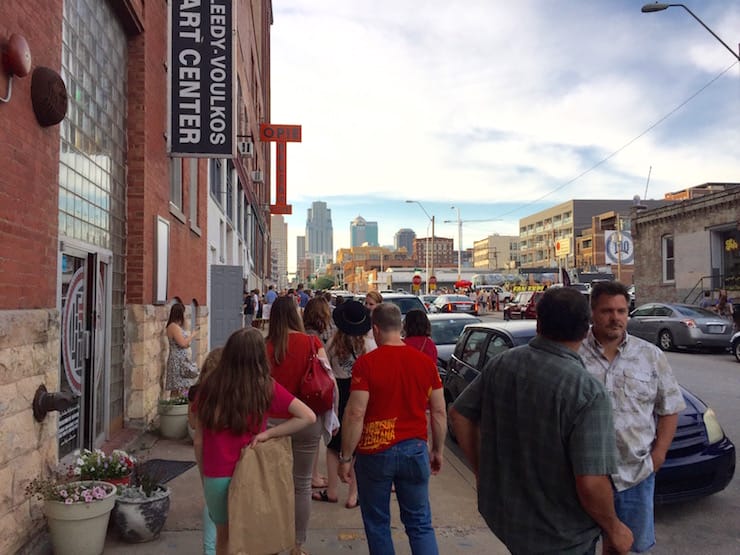
Published December 30th, 2021 at 12:30 PM
Editor’s note: This article originally was published March 16, 2021)
By Kevin Collison
When the Crossroads Community Association began 20 years ago, its sprawling 90-block turf of old, brick commercial buildings sandwiched between downtown and Crown Center was facing an identity crisis.
The area was finishing its pioneering phase that began in 1985 when artist Jim Leedy (he died Dec. 26) found real estate cheap enough in the deserted district to open his studio and gallery at 2012 Baltimore, but its future direction was uncertain.
“There had been some animosity between artists, tenants, property owners and developers,” recalled attorney Bill Quick, who prepared the Association’s charter.
“But the glue that brought everyone together was downtown was moving forward on the Power & Light District and was trying to assert itself south of Truman Road. We didn’t wanted to be subjugated.
“We said ‘this is our neighborhood and we’ve ridden out the hard times.'”
Two decades later, the association has 250 members including artists, business owners, landlords and residents, and has shepherded a dynamic neighborhood that’s one of greater downtown’s premier places to visit and live.
“It’s been an amazing transformation,” said Robert Harris, the current president of the Crossroads Community Association. “It’s taken some real pioneers and people with vision to take that risk.”

Suzie Aron (Photo by Julie Denesha courtesy of KCUR)
Suzie Aron, the association’s first president, said the unifying force between all the disparate groups has been a desire to build a strong community.
“We’ve been extraordinarily fortunate that our property owners and tenants grew together as a neighborhood,” she said.
Quick came to Kansas City in 1997 to work as an attorney for a big law firm. One of his clients was Derek Porter Studios, a lighting design firm located next door to what was then the Dolphin Gallery at 19th and Baltimore.
After a meeting with his client, he was invited to stop by a neighborhood meeting at the Dolphin.
“I’d been in town a year or so and I met this group and they seemed to have interesting ideas,” he said. “It was a neat part of town that was growing and was a hidden gem.”
But it was having problems as more people were being attracted by its charms. There were several day labor centers that didn’t offer restrooms to their workers, prompting them to use the alleys as bathrooms.
Car break-ins and burglaries were common, vagrants were buying cheap liquor and trashing the alleys, and squatters were breaking into vacant buildings to live.
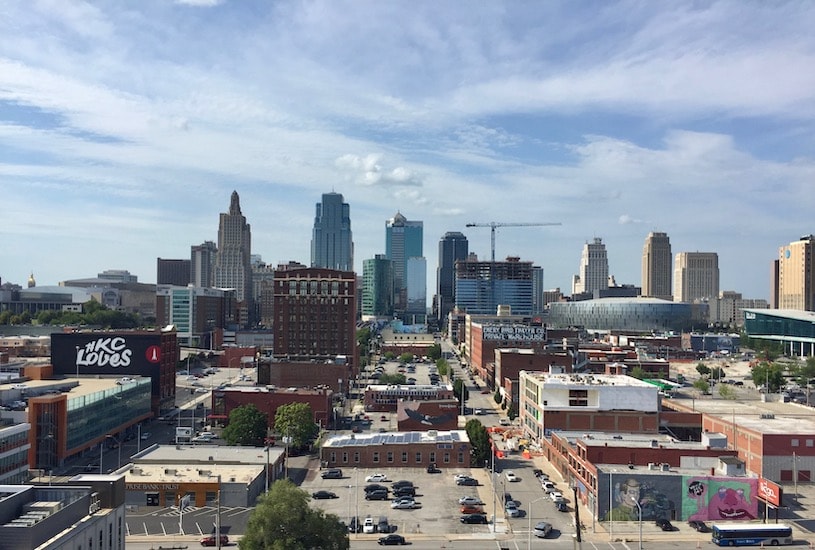
Downtown skyline from the Crossroads.
“We had to come together and do something because we weren’t getting the responsiveness from the police we liked, and the city was trying to impose on us,” he said.
It took about three years to be able to “thread the needle” between all the different interest groups to establish the Crossroads Community Association, Quick said.
Even the boundaries were disputed.
The organization decided to define the Crossroads Arts District according to the city FOCUS plan, between I-35 on the west, Troost on the east, the South Loop on the north, and the Central Terminal tracks on the south.
But Westside residents resisted the I-35 boundary, insisting on Broadway. The territory between the highway and street remains a twilight zone, with businesses wanting to be part of the Crossroads and residents part of the Westside.
The first board members of the association were: Brad Nicholson, Mike Rainen, Tom Levitt, Derek Porter, Aron, Marilyn Block, Robyn Nichols, Leedy and Dodie Jacobi.
From almost the beginning, two big issues have run through the history of the Association, both connected to the area’s growing popularity: First Fridays and gentrification.
As the district became more appealing, developers began snapping up its old buildings to renovate them into apartments, restaurants and other uses. New residential construction also got underway in earnest with the ARTerra apartment project at 20th and Wyandotte.
As property values began to rise, so did rents, threatening to drive out the artists and galleries that had created the unique identity of the Crossroads.
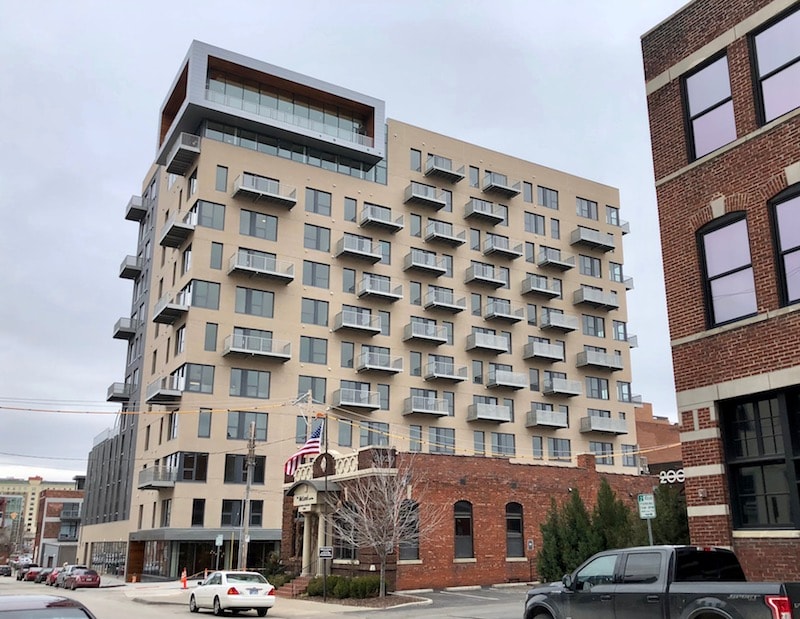
The 12-story ARTerra apartment building was the first new apartment tower to be built in the Crossroads Arts District.
In 2006, the same tax incentive tool that had helped developers was adopted to preserve its longtime creative residents. Buildings used primarily for arts uses were granted a 100 percent property tax abatement by a city development agency for 10 years.
That program was renewed again for 15 years in 2016, with a lower 50 percent abatement.
“The whole purpose was to stabilize the rents,” Aron said.
While the program has allowed many existing studios and galleries to remain in the Crossroads, these days the area seldom is the destination for new artists.
“I think the artists would complain the Crossroads has gentrified and taken away the gritty and lawless character that drew them originally,” Quick said.
“Rents have gone up and artists have been moving to the West Bottoms and east of Troost.”
As for First Fridays, like so much of the Crossroads, the event began in an organic, low-key fashion. Gallery owners began opened their doors for a joint open house event the first Fridays of the month as early as 1999.
In those early days, patrons could grab a free glass of wine or beer at the gallery and then wander down the street to the next venue. That free-spirited event stopped when the city cracked down in the early 2000s.
Rather than go through the hassle of getting a city permit with all the monitoring required to prevent underage drinking, the galleries ended the practice.
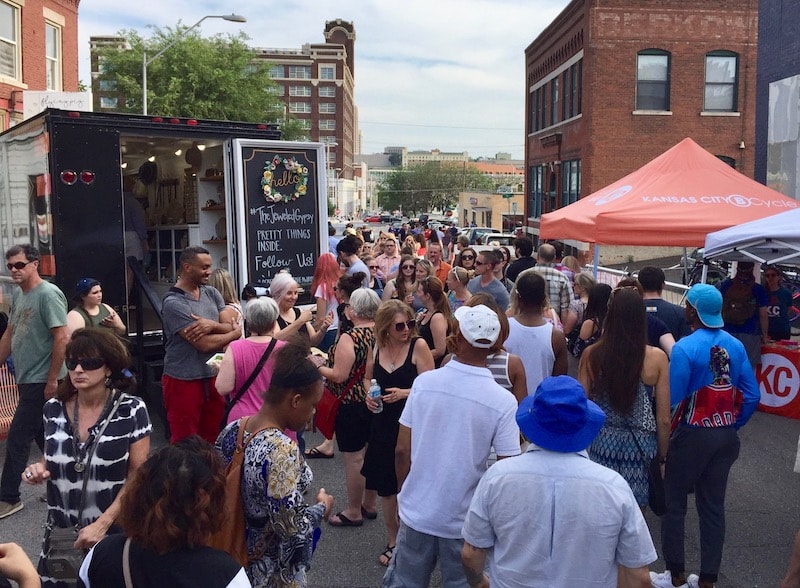
First Fridays grew in popularity to become a street festival draw ing up to 20,000 people.
But First Fridays kept growing in popularity, becoming one of downtown’s biggest events during fair weather.
By the summer of 2019 it had grown to the point an estimated 20,000 people with 54 food trucks and vendors hawking wares on the sidewalks.
All that ended abruptly in August of that year when a young woman from Overland Park standing at a food truck was killed by a stray bullet fired during a fight by a group of youths a block away.
That horrible, random crime stunned a neighborhood founded on the idea of creativity and solidarity between people of many unique backgrounds.
“More than 150 neighbors showed up after the murder to ask what kind of neighborhood we want to be?” Aron said.
A decision was made to try to return First Fridays to its roots as a day to showcase the arts. But the plan to roll out a revamped, quieter event in 2020 was delayed when the Covid-19 outbreak began last spring.
Now, the Crossroads Community Association is poised for a new chapter.
The organization had been on the verge of launching a long-anticipated community improvement district when the pandemic hit.
CIDs, which have been adopted in other areas of greater downtown and the city to improve safety and maintenance, require a majority of the businesses and property owners to sign up and pay additional taxes.
“The plan was in place, but when Covid came, everybody disappeared and nobody knew who would still be in business,” Aron said.
So the association created what Harris called a “CID lite” with a security patrol and a maintenance crew that tries to keep a handle on removing graffiti.
“We’re still a community association trying to do things to make our community,” Harris said.
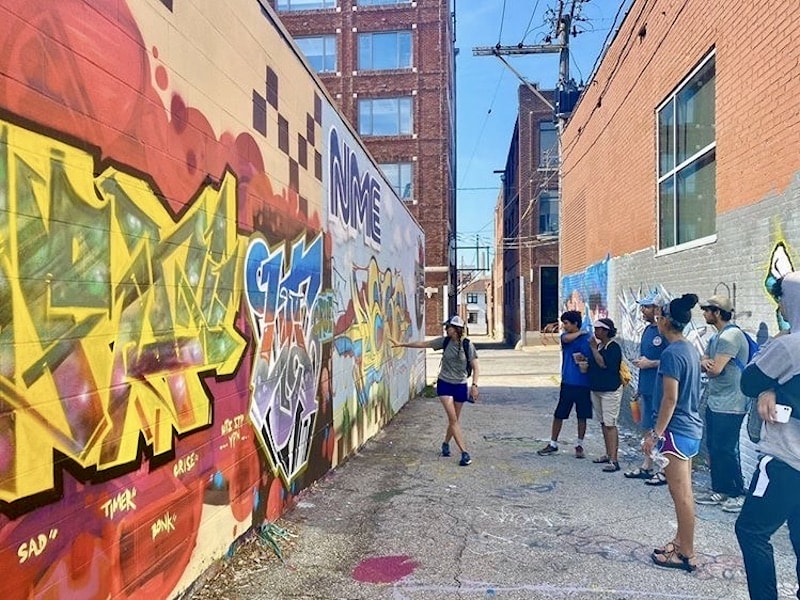
Urban Hikes tours include exploring the alleys of the Crossroads District for street art. (Photo by Rebekah Baughman)
The circumstance of Harris coming to the Crossroads is part of the changing character of the area first pioneered by artists.
He was working for a suburban engineering firm seven years ago when its lease was coming up. Harris was familiar with the Crossroads because his wife, artist Lisa Lala, frequently had shows at the Blue Gallery.
Harris persuaded his colleagues to move to 310 W. 20th St. and now Dialectic Engineering employs 65 people there.
“It was the best thing we ever did,” he said. “We wanted to be in a neighborhood with creative juices flowing that was walkable.”
That’s the way Harris would like to see the Crossroads evolve in the near term.
“I’d hope in 10 years and before then the neighborhood will continue to change,” he said. “We’ve done a lot to keep artists in the area and we want it to stay the Crossroads Arts District.
“We’re also getting a little tech start-up activity. We want it to be a mixed use neighborhood. We don’t want it to be the party district.
“It also would be nice to have an affordable housing component. We don’t want to price people out of the neighborhood.”


